Topics
Category
Era
Blue Mounds State Park
Blue Mounds State Park, named for a long, high Sioux quartzite cliff, is located in southwestern Minnesota on the Iowa and South Dakota borders. The cliff, one and one-half miles long and up to ninety feet high, appeared to be blue in color to the early Euro-American immigrants who saw it from a distance. A unique herd of bison, the largest North American mammal, makes its home in the park on 533 acres of native tall grass prairie, which escaped plowing due to poor soil quality.
Located on 1,830 acres, the park is in an area known as Coteau des Prairies (in English, a hilly prairie upland). As high as 2,000 feet above sea level, the plateau runs from southeast North Dakota, through southwest Minnesota, and into northwestern Iowa. Dating to 1,700 million years ago, numerous Sioux quartzite outcrops and boulders, colored pink, red, white, and purple, can be seen in the fields.
The old quartzite quarries in the park were owned and operated by the Luverne Granite Company. The stone was used to construct many local buildings, such as the Rock County Courthouse (1882), the old city hall (ca. 1890s), Trinity Episcopal Church (1891), and the Hinkly House in Luverne (1892).
Before white immigrants came, the eastern cougar, elk, pronghorn antelope, grizzly bear, bison, prairie dog, and prairie chicken all inhabited the southwestern Minnesota prairie. Because of habitat changes caused by settlement, only bison, commonly known as buffalo, now live in the park.
In 1961, the current herd of North American plains bison (scientific name Bison bison) began when three bison were relocated from the Fort Niobrara Wildlife Refuge near Valentine, Nebraska, to the park. Many of the bison in commercial herds in the United States carry cattle genes; however, DNA testing, using blood and tail hair, shows that the Blue Mounds herd is among the most genetically pure in the country. To promote healthy herds, increase genetic diversity, and prevent inbreeding, park staff participate in a national conservation program that exchanges bison among pure herds. The pasture in the park can sustain about seventy-five mature animals, and park visitors can view them from an observation platform.
Running across 1,250 feet on top of the Blue Mound is a mysterious wall—as much as five feet in height in some places—composed of rocks and small-to-huge boulders. The sunrise and sunset on the spring and fall equinox closely align with the wall’s east-west orientation. Theories about the wall’s origin and purpose include that it was an early white-immigrant-constructed wall; a Minnesota equivalent of England’s Stonehenge; and a barrier to help Indians stampede bison off the cliff during hunts. Surveys and excavation of the wall in the 1980s, however, concluded that the wall was built after the mid 1800’s. In the 2010s, the issue remains unresolved.
Beginning in 1938, workers in the WPA (Works Progress Administration) built five structures in the park: a latrine and the upper and lower dams on Mound Creek, which created Upper and Lower Mound Lakes. The rustic style of the structures features native materials such as locally quarried quartzite. Rustic-style architecture, as defined by the National Park Service, is labor intensive, finely crafted, and uniquely American.
The Upper and Lower Mound Lakes were once the only lakes in Rock County. In 2014, over eleven inches of rain destroyed the lower dam. This caused Lower Mound Lake—then the only recreational lake in Rock County—to drain. In 2016, the Minnesota Department of Natural Resources decided not to make repairs to the dam that would have restored Lower Mound Lake.
Visitors to the park enjoy hiking on three main trails, biking, rock climbing, spotting bison, camping, birding, and exploring for flora and fauna. Campers can spend the night in a tipi and snowmobile in the winter. Native prickly pear cactus grows in the quartzite outcrops, and birders may spot the uncommon blue grosbeak. Mound Creek is home to the Topeka Shiner (Notropis tristis), a small minnow that is on the U.S. Fish and Wild Life Service’s endangered species list. The park is the only place in Minnesota where the lined snake (Tropidoclonion lineatum) is found.
Bibliography
Allen, Bill. “Bona Fide Bison.” Minnesota Conservation Volunteer no. 76 (November–December 2013): 21–31.
Barmore, Frank E. “The Blue Mounds Stone Wall: Astronomical Significance and Antiquity.” Minnesota Archaeologist 44 (Fall, Winter 1985): 41–49.
Blue Mounds State Park WPA/Rustic Style Historic Resources. Blue Mounds State Park. National Register of Historic Places Registration Form.
http://npgallery.nps.gov/nrhp/GetAsset?assetID=4b682532-8b40-4091-93b3-b98ece1c37a7
Hudson, Lew. “Blue Mounds Stone Fence.” Minnesota Archaeologist 37 (May 1978): 50–55.
Ingebretsen, Chris. Personal communication with the author, September 22, 2016.
Lothson, Gordon A. “Test Excavation at the Rock Wall Site, 21 RK 8, Blue Mounds State Park.” Minnesota Archaeologist 45 (Spring, Summer 1986): 37–47.
Meyer, Roy W. Everyone’s Country Estate: A History of Minnesota’s State Parks. St. Paul: Minnesota Historical Society Press, 1991.
Minnesota Department of Natural Resources. A Management Plan for Blue Mounds State Park, May, 1979.
https://www.leg.state.mn.us/edocs/edocs?oclcnumber=07255492
Minnesota Department of Natural Resources. Blue Mounds State Park.
http://www.dnr.state.mn.us/state_parks/blue_mounds/index.html
Minnesota Department of Natural Resources. Minneopa State Park Management Plan Amendment, Bison Reintroduction, August, 2014.
http://files.dnr.state.mn.us/input/mgmtplans/parks/minneopa_bison_amendment.pdf
Minnesota Department of Natural Resources. Blue Mounds State Park Map.
http://files.dnr.state.mn.us/maps/state_parks/spk00121.pdf
Minnesota Department of Natural Resources, Notropis tristis, Topeka Shiner.
http://www.dnr.state.mn.us/rsg/profile.html?action=elementDetail&selectedElement=AFCJB28960
Minnesota Department of Natural Resources. Tropidoclonion lineatum, Lined Snake.
http://www.dnr.state.mn.us/rsg/profile.html?action=elementDetail&selectedElement=ARADB38010
“Mound Springs State Park is Open.” Rock Country Star Herald, May 10, 1951.
Ojakangas, Richard W. Roadside Geology of Minnesota. Missoula, MT: Mountain Press Publishing Company, 2009.
Rose, Arthur P. An Illustrated History of the Counties of Rock and Pipestone Minnesota. Luverne, MN: Northern History Publishing Company, 1911.
https://archive.org/stream/illustratedhistorrpm00rose#page/236/mode/2up
175 r.6
Plat book of Rock County
Map Collection, Minnesota Historical Society, St. Paul
Description: Plat book of Rock County, Mound Township, Minnesota, 1886.
U.S. Department of the Interior. 15 Facts about our National Mammal: The American Bison.
https://www.doi.gov/blog/15-facts-about-our-national-mammal-american-bison
Related Resources
Secondary
Jirsa, Mark, et al. Geology of Blue Mounds State Park, Final Report for Minnesota Department of Natural Resources Contract #93015 with the Minnesota Geological Survey, University of Minnesota: Twin Cities, 2015.
ftp://ftp.gisdata.mn.gov/pub/gdrs/data/pub/us_mn_state_dnr/geos_blue_mounds_state_park/metadata/BMgeology.pdf
Minnesota Department of Natural Resources. Blue Mounds State Park Bird Checklist.
http://files.dnr.state.mn.us/destinations/state_parks/blue_mounds/bird_checklist.pdf
Minnesota Department of Natural Resources. Opuntia macrorhiza.
http://www.dnr.state.mn.us/rsg/profile.html?action=elementDetail&selectedElement=PDCAC0D0T0
Rock County Historical Society. A History of Rock County from 1911 to 1976. [MN]: Rock County Historical Society and Mrs. Jaycees Luverne, 1977.
Related Images

Bison jump site at Blue Mounds State Park
All rights reserved
Holding Location
Articles

Workers and a mule at a quarry in what now is Blue Mounds State Park
Public domain
Holding Location
Articles
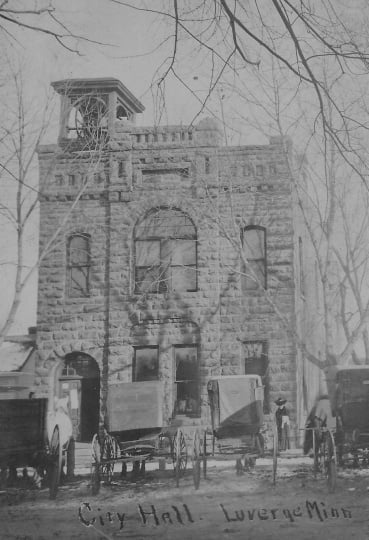
Old Luverne city hall
Public domain
Holding Location
Articles
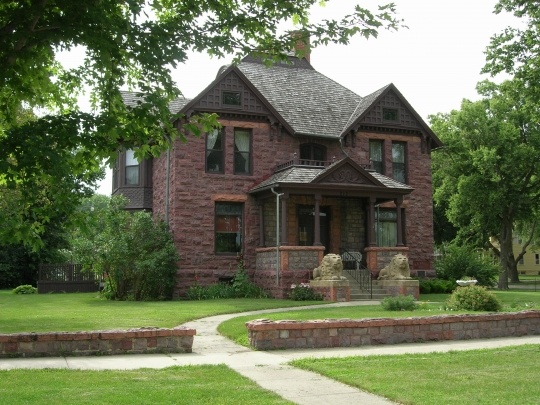
The Hinkly House
All rights reserved
Holding Location
Articles

Adult bison and calves at Blue Mounds State Park
Holding Location
Articles
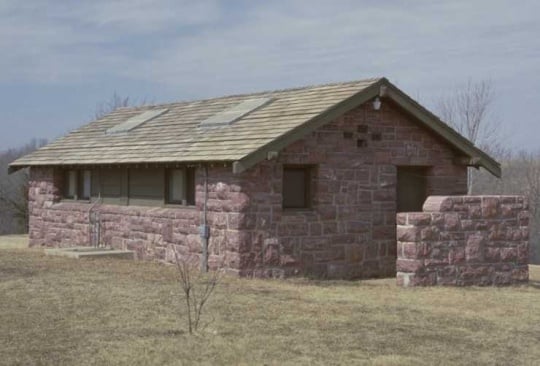
Blue Mounds State Park latrine built by the Works Progress Administration
Public domain
Holding Location
Articles
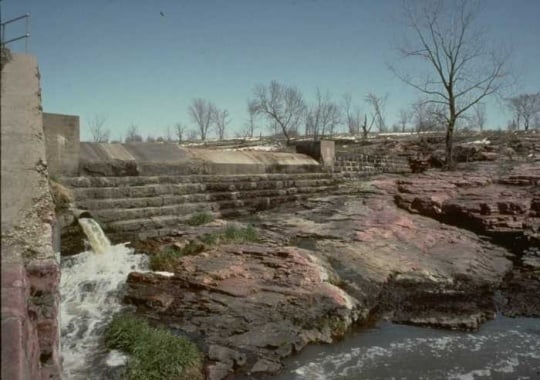
Upper Dam, Blue Mounds State Park
Public domain
Holding Location
Articles
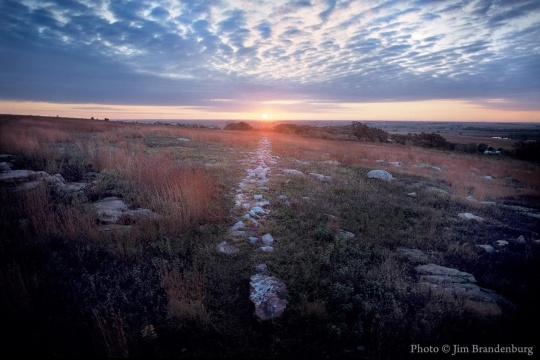
Sunrise during the autumnal equinox in Blue Mounds State Park
All rights reserved
Holding Location
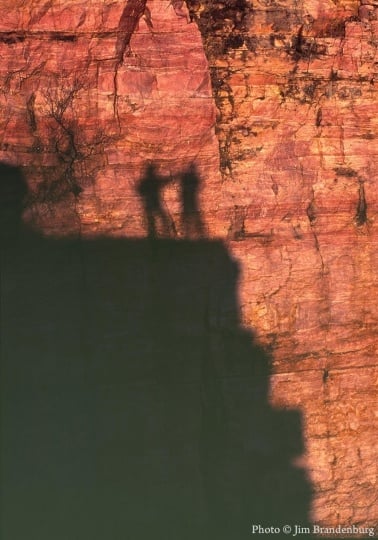
Shadows of visitors to Blue Mounds Quarry
All rights reserved
Holding Location
Articles
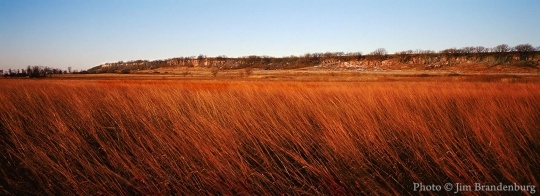
Bluestem (prairie grass) with a quartzite outcrop in the background inside Blue Mounds State Park
All rights reserved
Holding Location
Articles
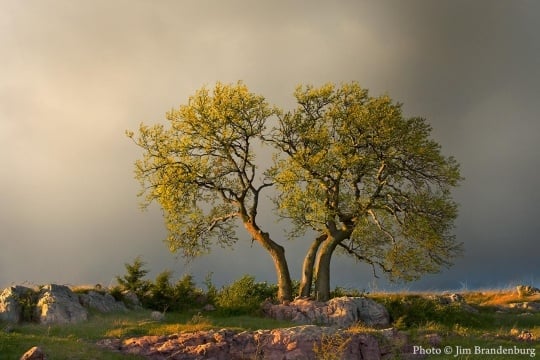
“Three Sisters” tree in Blue Mounds State Park
All rights reserved
Holding Location
Articles

Eagle Rock at sunset
All rights reserved
Holding Location
Articles
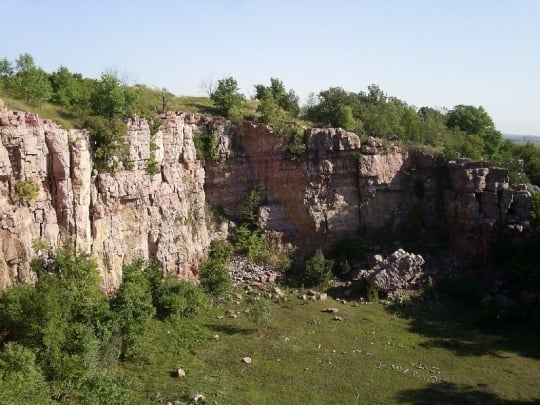
Sioux quartzite cliff in Blue Mounds State Park
Public domain
Articles
More Information
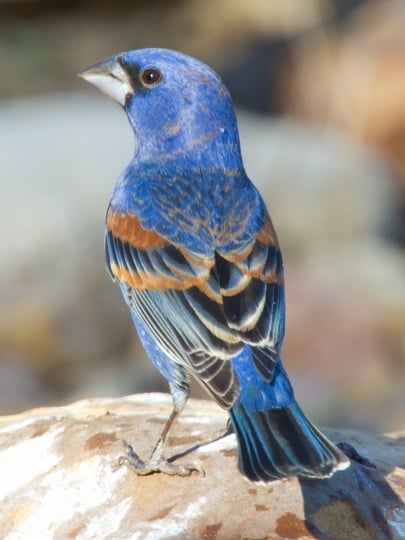
Blue grosbeak
Holding Location
Articles
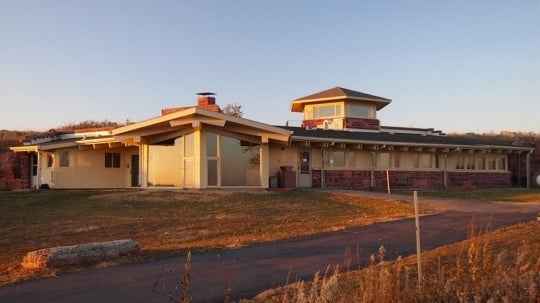
Blue Mounds State Park interpretive center
Holding Location
Articles
More Information
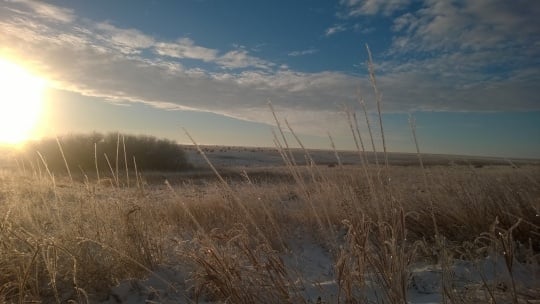
Frozen prairie with distant bison herd
All rights reserved
Holding Location
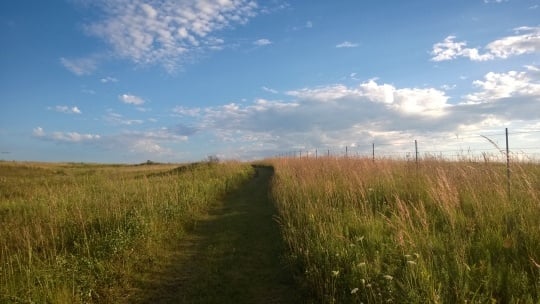
Mound hiking trail
All rights reserved
Holding Location
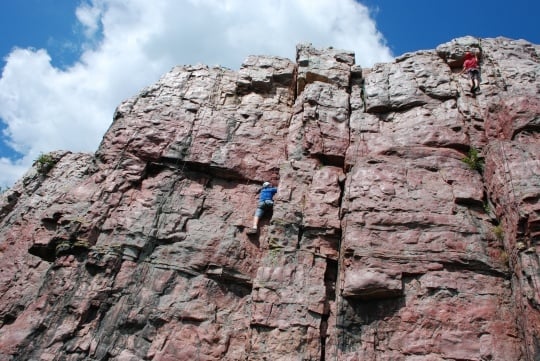
Rock climbing, Blue Mounds State Park
Holding Location
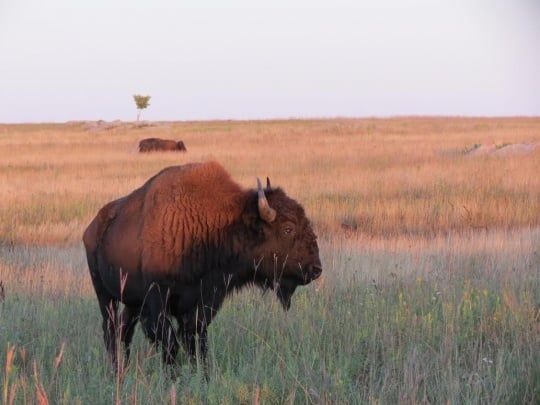
Bison herd, Blue Mounds State Park
All rights reserved
Holding Location
Related Articles
Turning Point
In 1961, three bison are relocated from the Fort Niobrara Wildlife Refuge near Valentine, Nebraska to the park. The animals establish a new herd in Minnesota.
Chronology
1,700 million years ago
ca. 1870s
1876
1937
1938
1939
1951
1961
1976
1985
1986
1989
2014
2016
2016
Bibliography
Allen, Bill. “Bona Fide Bison.” Minnesota Conservation Volunteer no. 76 (November–December 2013): 21–31.
Barmore, Frank E. “The Blue Mounds Stone Wall: Astronomical Significance and Antiquity.” Minnesota Archaeologist 44 (Fall, Winter 1985): 41–49.
Blue Mounds State Park WPA/Rustic Style Historic Resources. Blue Mounds State Park. National Register of Historic Places Registration Form.
http://npgallery.nps.gov/nrhp/GetAsset?assetID=4b682532-8b40-4091-93b3-b98ece1c37a7
Hudson, Lew. “Blue Mounds Stone Fence.” Minnesota Archaeologist 37 (May 1978): 50–55.
Ingebretsen, Chris. Personal communication with the author, September 22, 2016.
Lothson, Gordon A. “Test Excavation at the Rock Wall Site, 21 RK 8, Blue Mounds State Park.” Minnesota Archaeologist 45 (Spring, Summer 1986): 37–47.
Meyer, Roy W. Everyone’s Country Estate: A History of Minnesota’s State Parks. St. Paul: Minnesota Historical Society Press, 1991.
Minnesota Department of Natural Resources. A Management Plan for Blue Mounds State Park, May, 1979.
https://www.leg.state.mn.us/edocs/edocs?oclcnumber=07255492
Minnesota Department of Natural Resources. Blue Mounds State Park.
http://www.dnr.state.mn.us/state_parks/blue_mounds/index.html
Minnesota Department of Natural Resources. Minneopa State Park Management Plan Amendment, Bison Reintroduction, August, 2014.
http://files.dnr.state.mn.us/input/mgmtplans/parks/minneopa_bison_amendment.pdf
Minnesota Department of Natural Resources. Blue Mounds State Park Map.
http://files.dnr.state.mn.us/maps/state_parks/spk00121.pdf
Minnesota Department of Natural Resources, Notropis tristis, Topeka Shiner.
http://www.dnr.state.mn.us/rsg/profile.html?action=elementDetail&selectedElement=AFCJB28960
Minnesota Department of Natural Resources. Tropidoclonion lineatum, Lined Snake.
http://www.dnr.state.mn.us/rsg/profile.html?action=elementDetail&selectedElement=ARADB38010
“Mound Springs State Park is Open.” Rock Country Star Herald, May 10, 1951.
Ojakangas, Richard W. Roadside Geology of Minnesota. Missoula, MT: Mountain Press Publishing Company, 2009.
Rose, Arthur P. An Illustrated History of the Counties of Rock and Pipestone Minnesota. Luverne, MN: Northern History Publishing Company, 1911.
https://archive.org/stream/illustratedhistorrpm00rose#page/236/mode/2up
175 r.6
Plat book of Rock County
Map Collection, Minnesota Historical Society, St. Paul
Description: Plat book of Rock County, Mound Township, Minnesota, 1886.
U.S. Department of the Interior. 15 Facts about our National Mammal: The American Bison.
https://www.doi.gov/blog/15-facts-about-our-national-mammal-american-bison
Related Resources
Secondary
Jirsa, Mark, et al. Geology of Blue Mounds State Park, Final Report for Minnesota Department of Natural Resources Contract #93015 with the Minnesota Geological Survey, University of Minnesota: Twin Cities, 2015.
ftp://ftp.gisdata.mn.gov/pub/gdrs/data/pub/us_mn_state_dnr/geos_blue_mounds_state_park/metadata/BMgeology.pdf
Minnesota Department of Natural Resources. Blue Mounds State Park Bird Checklist.
http://files.dnr.state.mn.us/destinations/state_parks/blue_mounds/bird_checklist.pdf
Minnesota Department of Natural Resources. Opuntia macrorhiza.
http://www.dnr.state.mn.us/rsg/profile.html?action=elementDetail&selectedElement=PDCAC0D0T0
Rock County Historical Society. A History of Rock County from 1911 to 1976. [MN]: Rock County Historical Society and Mrs. Jaycees Luverne, 1977.




















